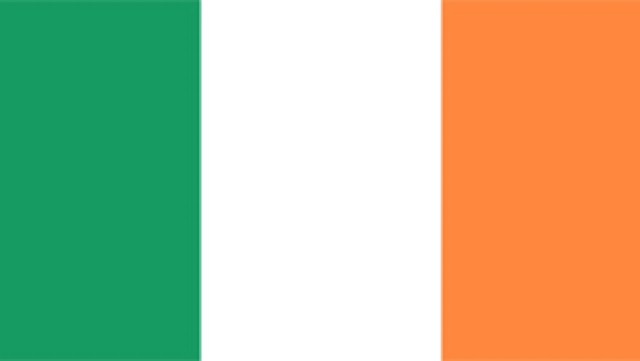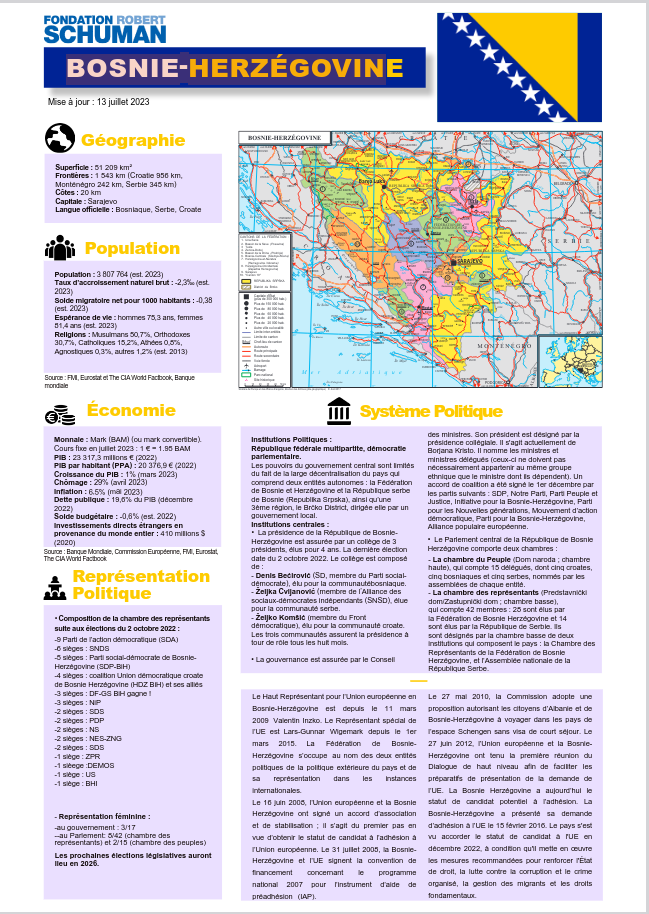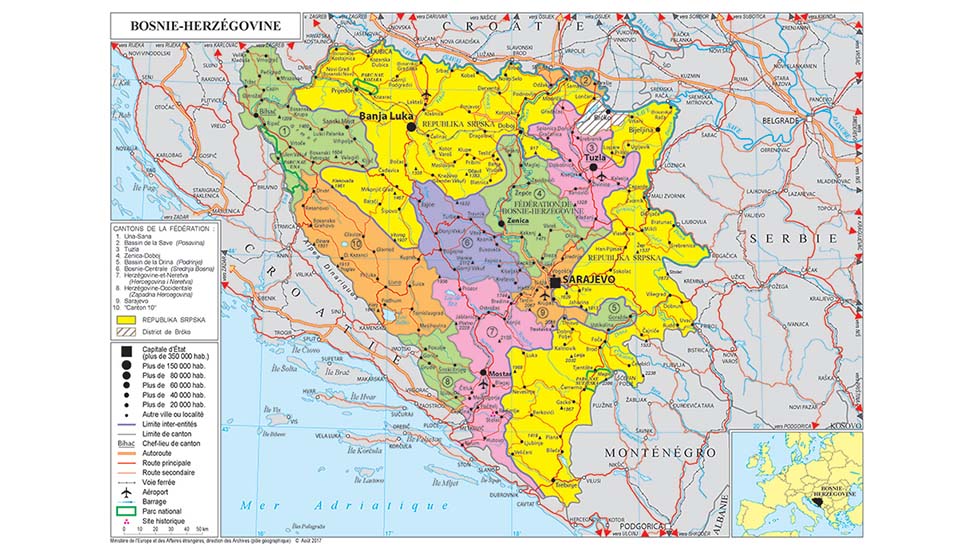
Geography
Area : 51,209 km²
Borders : 1,543 km (Croatia 956 km, Montenegro 242 km, Serbia 345 km)
Coastline : 20 km
Capital : Sarajevo
Official language : Bosnian, Serbian, Croatian
Source : The CIA World Factbook
Flag
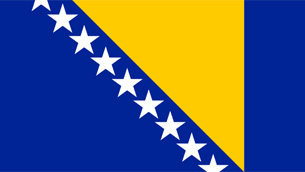
Population
Population : 3,429,142 (2023)
Crude natural change rate : -2.8‰ (2023)
Population repartition: 15% under 15, 19% over 65 (2024)
Crude net migration rate: -4.3‰ (2023)
First time asylum applicants: 110 (2023)
Life expectancy: men 74.4 years, women 80.9 years (2023)
Religions: Muslim 50.7%, Orthodox 30.7%, Catholic 15.2%, Atheist 0.8%, Agnostic 0.3%, Other 1.2%, Undeclared/No response 1.1%. (2013 est.)
Ethnic groups: Bosnians 50.12%, Serbs 30.83%, Croats 15.43%, others 2.73% and undeclared 0.88% (2013)
Source : IMF, The CIA World Factbook
Economy
Currency: Mark (BAM) (or convertible mark). Fixed rate: €1 = 1.96 BAM
GDP: €25,452.0 million (2023)
GDP per capita (PPS): €6,733 (2022)
GDP growth : 2.1% (2023)
Inflation: 0.9% (October 2024)
Public debt: 28.1% of GDP (2023)
Unemployment: 12.5% (September 2024)
Stock of foreign direct investment from the entire world: 3.3% of GDP (2023)
Budget balance: -0.7% (est. 2023)
Source : IMF, The CIA World Factbook, World Bank
Political system
A federal, multi-party republic with a parliamentary democracy. The powers of central government are limited by the country's extensive decentralisation, which includes two autonomous entities: the Federation of Bosnia and Herzegovina and the Republika Srpska, as well as the autonomous territory of the Brčko district, which is governed by a local government.
Central Institutions : The Presidency of the Republic of Bosnia-Herzegovina is held by a college of 3 presidents, elected for 4 years. The last election was held on 2 October 2022.The college is composed of: - Denis Bećirović (SD, Social Democratic Party), elected for the Bosnian community. - Željka Cvijanović (SNS, Alliance of Independent Social Democrats), elected for the Serbian community. - Željko Komšić (DF, Democratic Front), elected for the Croatian community. The presidency rotates between the three communities every eight months. Governance is provided by the Council of Ministers. Its President is appointed by the Presidency. This is currently Borjana Kristo. The President appoints ministers and deputy ministers (who need not belong to the same ethnic group as the minister to whom they report). The government is composed of 6 parties: HDZ BiH, SNSD, SDP-BiH, NiP, NS and DEMOS.
The Central Parliament of the Republic of Bosnia-Herzegovina has two chambers: - The House of the People (Dom naroda; upper house), which has 15 delegates, including five Croats, five Bosniaks and five Serbs, appointed by the assemblies of each entity. - The House of Representatives (Predstavnički dom/Zastupnički dom; lower house), which has 42 members: 28 are elected by the Federation of Bosnia and Herzegovina and 14 are elected by Republika Srpska. They are appointed by the lower house of two institutions that make up the country: the House of Representatives of the Federation and the National Assembly of the Republic of Serbia.
Political representation
Composition of the Chamber of Representatives in december 2024 :
- 8 seats SDA (Party of Democratic Action, Bosnian)
- 6 seats SNSD (Alliance of Independent Social Democrats, Serbian populist)
- 5 seats SDP-BiH (Social Democratic Party of Bosnia-Herzegovina)
- 4 seats HDZ BiH (Croatian Democratic Union Coalition of Bosnia and Herzegovina and its allies)
- 3 seats DF-GS (Democratic Front and its ally Civic Alliance)
- 3 seats NiP (People and Justice)
- 2 seats SDS (Serbian Democratic Party)
- 2 seats PDP (Party for Democratic Progress)
- 2 seats NS (Our Party)
- 2 seats NES (European Union of Citizens of Bosnia-Herzegovina)
- 1 seat ZPR (For Justice and Order)
- 1 seat DEMOS (Democratic Alliance)
- 1 seat US (Serbian Union)
- 1 seat BHI (Bosnia-Herzegovina Initiative)
- 1 seat NPD (Forward Bosnia and Herzegovina)
Relations with the EU
- The International High Representative in Bosnia and Herzegovina (OHR) is Christian Schmidt since 1 August 2021. The Federation of Bosnia and Herzegovina is responsible, on behalf of the two political entities, for the country's foreign policy and its representation in international bodies. On 16 June 2008, the European Union and Bosnia-Herzegovina signed an Association and Stabilisation Agreement (SAA). On 27 May 2010, the Commission adopted a proposal allowing citizens of Albania and Bosnia-Herzegovina to travel to Schengen countries without a short-stay visa.
- Bosnia and Herzegovina applied for EU membership on 15 February 2016. In December 2022, the country was granted EU candidate country status on the understanding that it would implement the measures recommended to strengthen the rule of law, the fight against corruption and organised crime, the management of migrants and fundamental rights.
- In March 2024, EU leaders gave the green light to the opening of accession negotiations, on the basis of the Commission's recommendation of 12 March 2024. To this end, they invited the Commission to prepare the negotiating framework.
Women's representations
- in the government: 2/10
- in Parliament: 10/42 (House of Representatives)
- and 2/15 (House of the People)
Next Elections:
On The Same Theme
Country Sheet
Country Sheet
Country Sheet
Country Sheet
Country Sheet
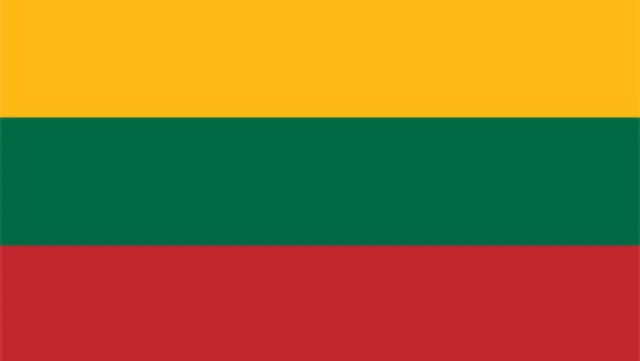
Country Sheet
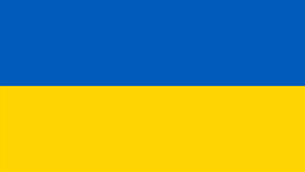
Country Sheet
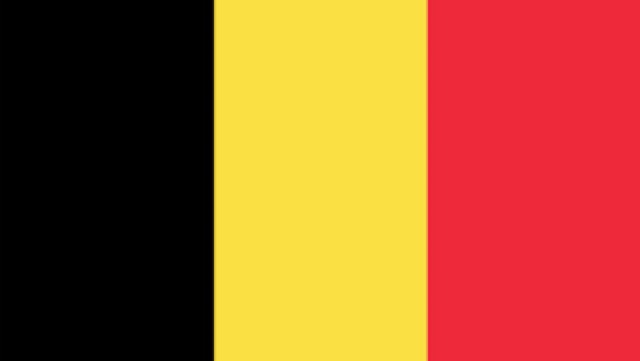
Country Sheet
